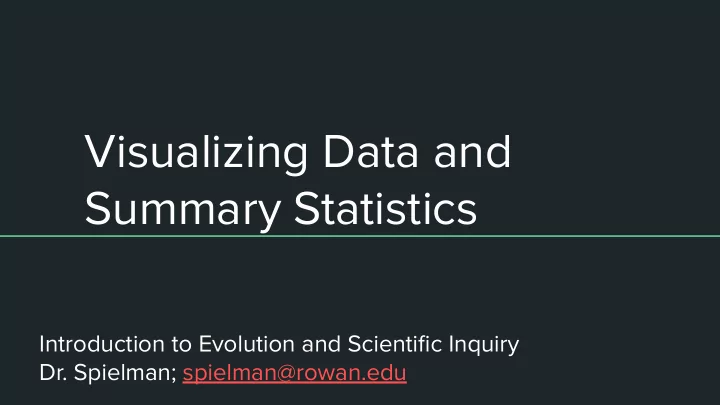

Visualizing Data and Summary Statistics Introduction to Evolution and Scientific Inquiry Dr. Spielman; spielman@rowan.edu
Quantitative vs. Categorical variables ● Quantitative variables are described by data as numbers Height of a plant ○ ○ Number of legs on an octopus Length of gestation time ○ ● Categorical variables are described by data as categories ○ Colors Species names ○ ○ iPhone models
There are two types of quantitative data ● Continuous Any real-number value within some range ○ ○ Example: height, weight, If it can be a decimal, it is continuous ○ ● Discrete (also known as discontinuous in book) ○ Values are in indivisible units, i.e. whole or counting numbers "Count data" ○ ○ If it can NOT have a decimal (i.e. there are not 2.5 people), it is discrete Note: discreet is different. ●
How we represent data depends on what kind it is Visualize how two quantitative variables Visualize quantitative data Visualize categorical data* relate Histogram Boxplot Bar plot Scatterplot *Commonly used for quantitative data as well, but it “shouldn’t be”
Histograms
Boxplots
Boxplots vs. histograms
Barplots In my garden, there are… ● 18 orange flowers ● 37 pink flowers ● 62 red flowers 15 white flowers ●
Barplots for quantitative data Height of bar = mean Length of tick = 2*standard deviation (usually!)
Barplots can be very misleading though! std dev Mean
Scatterplots X-axis shows independent variable ● Y-axis shows dependent (response) variable ●
Describing the location of a distribution ● Location is a fancy word for “center” Mean and median for quantitative data ○ ○ Mode for categorical data
Describing the spread of a distribution ● Range 1, 2, 3, 7, 9 → 8 ○ ○ 1, 2, 3, 7, 9, 500 → 499 Standard deviation ● Variance = s 2 ○ ● Interquartile Range (IQR) Middle 50% of the numbers (goes with median) ○
Comparing spreads of two different distributions
A note on the word population ● In biology , a population is group of organisms of a single species who live around the same area In statistics , a population is total set of observations, data points, etc. that can ● be made ○ Except in a few cases, we generally never know the population
Statistical Inference: Does my sample represent the true population?
How well does my sample represent the population? ● Standard Error: The distance between my measured statistic and the true population parameter SEM = Standard Error of the Mean ●
Standard deviation vs standard error ● Standard Deviation: how does the sample vary around the sample mean? Low SD = very narrow ○ ○ High SD = lots of spread ● Standard error of the mean: how does the sample mean compare to the population mean? ○ Low SEM: sample mean is very close to “true” mean ○ High SEM: sample mean is very far from “true” mean ○ Generally larger sample size yields lower SEM
Describing relationships between quantitative variables ● One common measure is correlation The Pearson Correlation Coefficient: -1 <= r <= 1 ●
Major Correlation Caveats ● Linear relationship only! (for now) Curves use different types of correlation coefficients ○ ● CORRELATION 👐 IS 👐 NOT 👐 CAUSATION 👐 ○ http://www.tylervigen.com/spurious-correlations
Explore quantitative data visualization https://sjspielman.shinyapps.io/plot-iris/ http://guessthecorrelation.com/
Recommend
More recommend